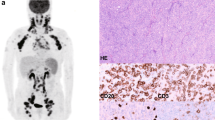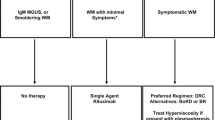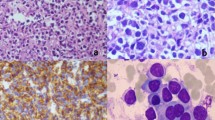Abstract
A 53-year-old woman was diagnosed with lymphoplasmacytic lymphoma (LPL)/Waldenström's macroglobulinemia (WM) in 2008. Six courses of R-COP (rituximab, cyclophosphamide, vincristine, and prednisolone) resulted in complete remission, but LPL/WM relapsed in 2015. After six courses of R-CHOP (rituximab, cyclophosphamide, doxorubicin, vincristine, prednisolone), the M-peak disappeared, but the patient presented with muscle weakness and sensory disturbance in the lower extremities. No lesions were apparent in the brain parenchyma, but T2-weighted magnetic resonance imaging (MRI) showed a signal-hyperintense area with contrast enhancement in the spinal cord at the C2–4 and Th2–3 levels, and cerebrospinal fluid (CSF) examination showed only a few mononuclear cells. In 2020, the patient started to require walking assistance, and MRI findings worsened. Neurologically, lower limb muscle strength was reduced (manual muscle test score 3), and sensations of touch and pain were about 30% of normal. Vibratory sensation was absent at the knees and medial malleoli, accompanied by dysuria due to neurogenic bladder. CSF cell count was 15/μl (all mononuclear cells). Bing–Neel syndrome (BNS) was diagnosed and tirabrutinib was started. Within 2 months of treatment, lower extremity muscle strength had normalized and MRI findings had improved. Tirabrutinib may offer a promising therapeutic option for BNS.



Similar content being viewed by others
References
Sekiguchi N, Rai S, Munakata W, Suzuki K, Handa H, Shibayama H, et al. A multicenter, open-label, phase II study of tirabrutinib (ONO/GS-4059) in patients with Waldenström’s macroglobulinemia. Cancer Sci. 2020;111:3327–37.
Narita Y, Nagane M, Mishima K, Terui Y, Arakawa Y, Yonezawa H, et al. Phase I/II study of tirabrutinib, a second-generation Bruton’s tyrosine kinase inhibitor, in relapsed/refractory primary central nervous system lymphoma. Neuro Oncol. 2021;23:122–33.
Malkani RG, Tallman M, Gottardi-Littell N, Karpus W, Marszalek L, Variakojis D, et al. Bing–Neel syndrome: an illustrative case and a comprehensive review of the published literature. J Neurooncol. 2010;96:301–12.
Simon L, Fitsiori A, Lemal R, Dupuis J, Carpentier B, Boudin L, et al. Bing–Neel syndrome, a rare complication of Waldenström macroglobulinemia: analysis of 44 cases and review of the literature. A study on behalf of the French Innovative Leukemia Organization (FILO). Haematologica. 2015;100:1587–94.
Castillo JJ, D’Sa S, Lunn MP, Minnema MC, Tedeschi A, Lansigan F, et al. Central nervous system involvement by Waldenström macroglobulinaemia (Bing–Neel syndrome): a multi-institutional retrospective study. Br J Haematol. 2016;172:709–15.
Minnema MC, Kimby E, D’Sa S, Fornecker LM, Poulain S, Snijders TJ, et al. Guideline for the diagnosis, treatment and response criteria for Bing–Neel syndrome. Haematologica. 2017;102:43–51.
Swerdlow SH, Campo E, Pileri SA, Harris NL, Stein H, Siebert R, et al. The 2016 revision of the World Health Organization classification of lymphoid neoplasms. Blood. 2016;127:2375–90.
Kulkarni T, Treon SP, Manning RA, Xu L, Rinne M, Lee EQ, et al. Clinical characteristics and treatment outcome of CNS involvement (Bing–Neel syndrome) in Waldenstroms macroglobulinemia. Blood. 2013;122:5090.
Vermeiren K, Lemmerling M, Louagie H, Vantomme M, Petrick M, Bouttens F, et al. Bing–Neel syndrome presenting as gait problems due to spinal cord involvement. Clin Neurol Neurosurg. 2018;167:59–61.
Cabannes-Hamy A, Lemal R, Goldwirt L, Poulain S, Amorim S, Pérignon R, et al. Efficacy of ibrutinib in the treatment of Bing–Neel syndrome. Am J Hematol. 2016;91:E17–9.
Boudin L, Patient M, Roméo E, Bladé JS, de Jauréguiberry JP. Efficacy of ibrutinib as first-line treatment of tumoral Bing–Neel syndrome. Leuk Lymphoma. 2018;59:2746–8.
Mason C, Savona S, Rini JN, Castillo JJ, Xu L, Hunter ZR, et al. Ibrutinib penetrates the blood brain barrier and shows efficacy in the therapy of Bing Neel syndrome. Br J Haematol. 2017;179:339–41.
Treon SP, Xu L, Yang G, Zhou Y, Liu X, Cao Y, et al. MYD88 L265P somatic mutation in Waldenström’s macroglobulinemia. N Engl J Med. 2012;367:826–33.
Yang G, Zhou Y, Liu X, Xu L, Cao Y, Manning RJ, et al. A mutation in MYD88 (L265P) supports the survival of lymphoplasmacytic cells by activation of Bruton tyrosine kinase in Waldenström macroglobulinemia. Blood. 2013;122:1222–32.
Argyropoulos KV, Vogel R, Ziegler C, Altan-Bonnet G, Velardi E, Calafiore M, et al. Clonal B cells in Waldenström’s macroglobulinemia exhibit functional features of chronic active B-cell receptor signaling. Leukemia. 2016;30:1116–25.
Munshi M, Liu X, Chen JG, Xu L, Tsakmaklis N, Demos MG, et al. SYK is activated by mutated MYD88 and drives pro-survival signaling in MYD88 driven B-cell lymphomas. Blood Cancer J. 2020;10:12.
Treon SP, Tripsas CK, Meid K, Warren D, Varma G, Green R, et al. Ibrutinib in previously treated Waldenström’s macroglobulinemia. N Engl J Med. 2015;372:1430–40.
Treon SP, Gustine J, Meid K, Yang G, Xu L, Liu X, et al. Ibrutinib monotherapy in symptomatic, treatment-naïve patients with Waldenström macroglobulinemia. J Clin Oncol. 2018;36:2755–61.
Bernard S, Goldwirt L, Amorim S, Brice P, Brière J, de Kerviler E, et al. Activity of ibrutinib in mantle cell lymphoma patients with central nervous system relapse. Blood. 2015;126:1695–8.
Tucker DL, Naylor G, Kruger A, Hamilton MS, Follows G, Rule SA. Ibrutinib is a safe and effective therapy for systemic mantle cell lymphoma with central nervous system involvement—a multi-centre case series from the United Kingdom. Br J Haematol. 2017;178:327–9.
Wanquet A, Birsen R, Lemal R, Hunault M, Leblond V, Aurran-Schleinitz T. Ibrutinib responsive central nervous system involvement in chronic lymphocytic leukemia. Blood. 2016;127:2356–8.
Wong J, Cher L, Griffiths J, Cohen A, Huang J, Wang L, et al. Efficacy of zanubrutinib in the treatment of Bing–Neel syndrome. Hemasphere. 2018;2:e155.
Author information
Authors and Affiliations
Corresponding author
Ethics declarations
Conflict of interest
The authors declare that they have no conflict of interest.
Additional information
Publisher's Note
Springer Nature remains neutral with regard to jurisdictional claims in published maps and institutional affiliations.
About this article
Cite this article
Saburi, M., Saburi, Y., Kawano, K. et al. Successful treatment with tirabrutinib for relapsed lymphoplasmacytic lymphoma complicated by Bing–Neel syndrome. Int J Hematol 115, 585–589 (2022). https://doi.org/10.1007/s12185-021-03246-z
Received:
Revised:
Accepted:
Published:
Issue Date:
DOI: https://doi.org/10.1007/s12185-021-03246-z




